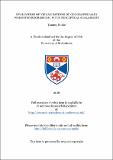Evaluation of visualisations of geographically weighted regression, with perceptual stability
Abstract
Given the large volume of data that is regularly accumulated, the need to properly manage,
efficiently display and correctly interpret, becomes more important. Complex analysis of data
is best performed using statistical models and in particular those with a geographical element
are best analysed using Spatial Statistical Methods, including local regression. Spatial Statistical
Methods are employed in a wide range of disciplines to analyse and interpret data where it is
necessary to detect significant spatial patterns or relationships. The topic of the research
presented in this thesis is an exploration of the most effective methods of visualising results.
A human being is capable of processing a vast amount of data as long as it is effectively
displayed. However, the perceptual load will at some point exceed the cognitive processing
ability and therefore the ability to comprehend data. Although increases in data scale did
increase the cognitive load and reduce processing, prior knowledge of geographical information
systems did not result in an overall processing advantage.
The empirical work in the thesis is divided into two parts. The first part aims to gain insight into
visualisations which would be effective for interpretation and analysis of Geographically
Weighted Regression (GWR), a popular Spatial Statistical Method. Three different visualisation
techniques; two dimensional, three dimensional and interactive, are evaluated through an
experiment comprising two data set sizes. Interactive visualisations perform best overall,
despite the apparent lack of researcher familiarity.
The increase in data volume can present additional complexity for researchers. Although the
evaluation of the first experiment augments understanding of effective visualisation display,
the scale at which data can be adequately presented within these visualisations is unclear.
Therefore, the second empirical investigation seeks to provide insight into data scalability, and
human cognitive limitations associated with data comprehension.
The general discussion concludes that there is a need to better inform researchers of the
potential of interactive visualisations. People do need to be properly trained to use these
systems, but the limits of human perceptual processing also need to be considered in order to
permit more efficient and insightful analysis.
Type
Thesis, PhD Doctor of Philosophy
Collections
Items in the St Andrews Research Repository are protected by copyright, with all rights reserved, unless otherwise indicated.

